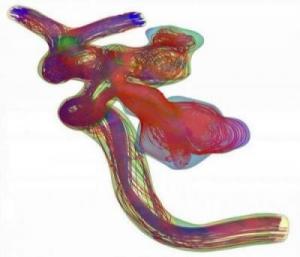Hang “Bill” Yi, a postdoctoral research fellow in the Department of Mechanical and Materials Engineering at Wright State University, recognizes the need for innovative diagnostic care in our healthcare system. His research, conducted through an academic collaboration with Wright State’s Boonshoft School of Medicine and Miami Valley Hospital-Premier Health, investigates the intricate mechanisms behind various human health conditions and is focused on devising time-saving interventions. Yi’s work encompasses areas such as the pathophysiology and treatment of intracranial aneurysms, respiratory diseases, ocular drug delivery and the application of machine learning in clinical diagnostics.
Yi and his research group, which includes his supervisors Dr. Zifeng Yang and Dr. Bryan Ludwig, are leading a pioneering project to develop a high-fidelity and efficient diagnostic pathway for cerebral aneurysms. This approach provides more accurate hemodynamic information about blood flow and behavior in the brain, which is essential for understanding cerebral aneurysms' onset, growth and rupture. The project's impact could be substantial, as it seeks to enhance both the accuracy and speed of diagnosing these potentially life-threatening conditions.
Yi’s approach is designed to make undergoing tests and scans much quicker for the patient. After a patient receives a CTA scan (a noninvasive medical test combining a CT scan with dye perfusion, a technique that uses injected dye to visualize blood flow), the image is transferred to Yi and his team to run through their model to undergo simulation. The doctors can more accurately determine the necessary course of action by comparing their scan with the hemodynamic information.

“Doctors can have this information much quicker than before. Combining the model’s futuristic diagnosing and the expedited timeline for getting these answers, it can potentially save someone’s life to get the care they need sooner,” Yi said.
During the research process on the model, Yi and his team identified the need for substantial computational resources to simulate dye perfusion, which involves tens of millions of computational cells. From a colleague's recommendation, the immense computational demands led Yi to the Ohio Supercomputer Center (OSC).
“We need a lot of data to make our model confident in its predictions,” Yi said. “We need to conduct many computational studies and implement machine learning for medical images. We wouldn’t have any of this without OSC.”
Leveraging OSC’s resources, Yi and his team were able to accelerate their computational processes significantly. What once took over two weeks on their lab’s workstations now takes just two days, greatly expediting their research and contributing to the successful graduation of one of their PhD students last year. Additionally, OSC’s $1,000 annual credit for academic research projects was instrumental in securing external funding, including some from the National Institutes of Health for their work.
The impact of OSC’s support is evident in Yi’s research outcomes. Over the past three years, the team has published over 10 journal articles and presented numerous conference papers and posters. Their work has also led to several research proposals, some of which are still under review. Yi is currently partnered with a hospital in Dayton and has plans to expand in the future, noting that restrictions on patient privacy can cause challenges with the amount of research and data they can collect from each hospital.
“The patient has to sign off on allowing us to use their data due to HIPPA protections. So, we need to make it clear that this is access we need to obtain,” he said.
Looking ahead, Yi envisions continued collaboration with OSC. He aims to refine his current model for cerebral aneurysms, allowing for a more rapid diagnosis using clinical medical images. As this will require extensive data to train machine learning models based on high-fidelity computational fluid dynamic modeling results, OSC’s computational power will be essential to the team’s ongoing and future research efforts.
Written by Lexi Biasi
Yi presented his research at OSC’s April 2024 Research Symposium, which is held annually each spring to create engagement within the high performance computing community.
The Ohio Supercomputer Center (OSC) addresses the rising computational demands of academic and industrial research communities by providing a robust shared infrastructure and proven expertise in advanced modeling, simulation and analysis. OSC empowers scientists with the services essential to making extraordinary discoveries and innovations, partners with businesses and industry to leverage computational science as a competitive force in the global knowledge economy and leads efforts to equip the workforce with the key technology skills required for 21st century jobs.